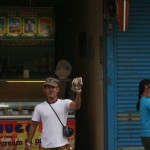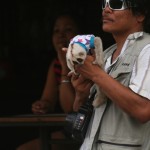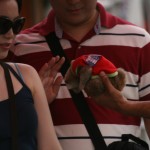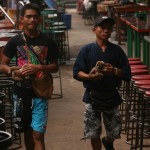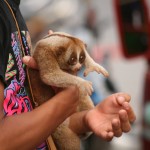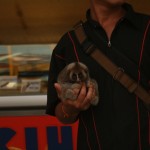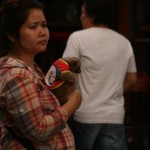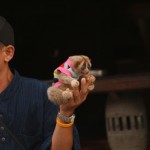By Petra Osterberg
There is clearly a lucrative market for wildlife as photo–prop animals in Phuket’s crowded tourist areas. For decades hundreds of thousands of tourists every year have been descending onto this tropical island to enjoy a holiday in the sun and part of the experience often includes holiday snaps with local exotic wildlife. Tourists are either unaware or unwilling to acknowledge the fact that these animals are most often endangered in the wild and that they are inevitably wild caught for this sad trade. There is absolutely no reason to pay the “owner” money in order for him to afford feeding his pet, as these animal handlers often claim to lure soft hearted tourists. There are no animal welfare concerns in this business. The animals are often drugged or mutilated in order to be safe to handle and once mature, too sick or otherwise unsuited for the job, they are discarded or locked in small cages to wither away. Rescue centers end up receiving some of these animals after confiscations by authorities, but rehabilitation is often made difficult by contagious diseases and physical and psychological damage to the animals caused by their traumatic time with humans.
Barely has the trade in baby gibbons here on Phuket trickled out, thanks at least partially to the collaboration between the local Thai Forestry Department and the Gibbon Rehabilitation Project (GRP), before the next new thing is here: the slow loris.
GRP has been keeping a record of gibbons and other wildlife used for entertainment around the island for many years now and 2012 has been the year when the lorises took over. From reports of a single loris spotted in Patong at the beginning of this year, by September we are receiving daily reports of up to 10 -15 slow lorises being paraded around in broad daylight. Many individuals are dressed up in cute little clothes and portrayed as anything but the wild, nocturnal, animals they are. And tourists appear to be falling for their charm. There is no shortage of paying customers for these photo shoots, as am I able to conclude on my most recent visit to Patong on the 10th of September. Within a few hours in a single afternoon we were able to identify nine individual lorises, belonging to several different subspecies of Nycticebus bengalensis.
Phuket island does have a native population of slow lorises, but no studies have been conducted here and since the island falls within a crossover zone between two species; Nycticebus cougang and bengalensis, it is as yet unknown which one is native here, or whether Phuket actually is a natural hybridization zone between the two. What is clear, however, is that many of the lorises exhibited for tourist photos in Patong have certainly been wild caught elsewhere inAsia and smuggled onto Phuket to make money on the tourists. Experts advise strongly against “hard releases” of captive slow lorises back into the wild, as reintroductions of this genus are extremely complicated. Further, it is strictly against international guidelines to release non-native species into areas where they do not belong.
To deal with this new problem and sudden influx of captive lorises in Phuket, authorities have a lot of catching up to do. Confiscations do not work as long as the punishment for offenders is so minuscule that they can pay their fine and return to the streets with new animals within a week or two. Reporting the offenders currently forces authorities to confiscate, which will only lead to even more lorises arriving here and suffering short, tragic lives. There is also currently no appropriate local rehabilitation centre with the capacity to house the large number of confiscated animals.
The root of the problem are the paying western tourists to Phuket who do not have a clue as to their own involvement in bringing an endangered species closer to the brink of extinction when they pay for a holiday photo. Educating western tourists here thus becomes the key in saving the slow loris from this new cruel fate that is threatening their survival.




